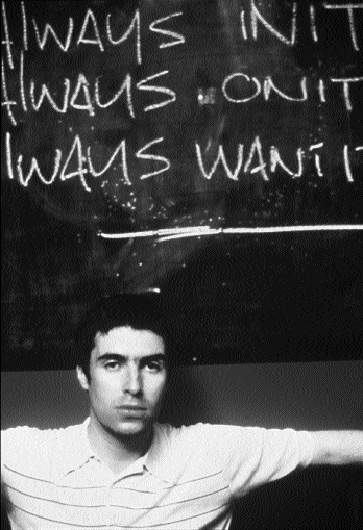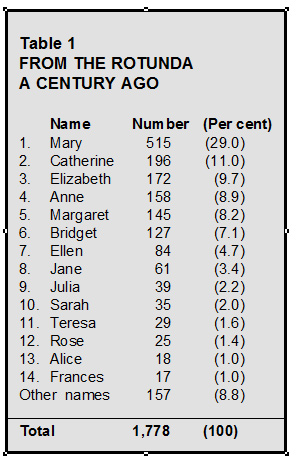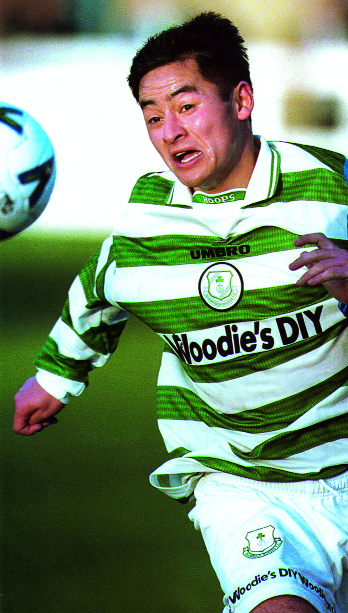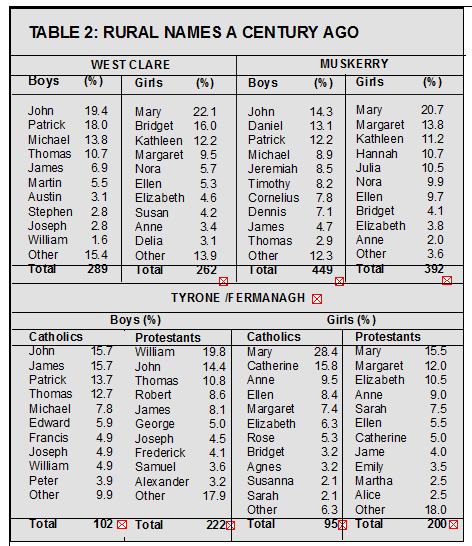Liam or Jason?
Published in Features, Issue 2 (Summer 1999), Volume 7One might be forgiven for believing that Dupont is the most common name in France, just as Smith is in England or Murphy is in Ireland. About twenty years ago, however, a learned article appeared in France with the title, Monsieur Dupont s’appelle Martin, et son prenom est Jean (Mr Dupont’s surname is Martin, and his first name is Jean). The article prompted considerable interest, although its analysis of surnames attracted more attention than that of first names. Some of the studies of Italian sociologist Emidio de Felice are also about surnames.

Liam…? (Hot Press)
One, I Nomi degli Italiani (Venezia 1982), is based on a scientific analysis of hundreds of thousands of names in Italian telephone directories; its grand but self-explanatory sub-title, Informazioni onomastiche e linguistiche, socioculturali e religiose captures its scope. Still, the issue of first name choice is also an interesting one, which has prompted a good deal of research by historians and sociologists, especially on the Continent. If how we dress and what we eat are supposed to tell stories about us, our choices of names tell some more.
Changing fashions
Everybody needs a name—and, sometimes, a nickname too. Names are a function of culture, fashion, and family pride. They also reflect religious and political beliefs and socio-economic background. Nearly five years ago an interesting article by Seamus Martin in The Irish Times (9 August 1993) described the changing fashions in naming choices in post-communist Russia: ‘retro’, pre-Leninist names such as Yekaterina and Elisaveta or Dmitri and Yaroslav were among the most popular—as opposed to, say, Joseph or Vladimir. In Ireland in the 1960s Jackie was a popular name for girls (after Jackie Kennedy), and in the late 1970s John Paul enjoyed a similar vogue (after Pope John Paul II). Working-class Dubliners were (or are) ridiculed by comedians and some serious writers too for their weakness for outlandish names revealing excessive piety (Dolores, Concepta, Assumpta) or little culture (Natasha, Samantha, Darren). The distaste is in part just snobbery, but as it happens, it has little basis in fact: such names were never as common in reality as the slagging of some of the intelligentsia implied. Yet some unlikely names can capture the popular imagination overnight. In the early 1970s in England the popularity of a television character made Jason (who remembers Jason King of ITV’s ‘Department S’?) into an extremely common boy’s name: in 1971 nearly 20,000 male infants were called Jason. At the other end of the social scale, certain names are valued for their snobbish associations: according to Leslie Dunkling, the author of a detailed analysis of naming choices in England two decades ago, parents who called their daughters Philippa felt ‘a major desire to avoid modern excesses of vulgarity and trend following’. Clearly there is considerable interest in middle-class naming fashions, as is evidenced in the Irish Times every Saturday, and also in similar columns in the London Times and Independent. But the most popular names in those newspapers have little in common with the choices of the common people. In England in 1971, for example, only two of the ‘top ten’ male names in The Times featured in the ‘top ten’ names chosen in the country as a whole.
Dublin a century ago
What about Ireland? According to Donnchadh Ó Corráin and Fidelma Maguire the Old Irish used a wide range of names for their offspring; thousands of them survive in the manuscripts. The Annals of Connacht contain dozens of wondrous names like Tomaltach, Gilliberd, Maelruanaid, and Mailir. But most of these names were probably seldom used or ephemeral. What kind of names were popular in Ireland a century ago? It turns out that the answer depends very much on the area in question. First I will give a short account of naming patterns among the poor and not-so-poor in Dublin at the end of the last century. In this case I limit the discussion to women’s names. Table 1 is based on a sample of mothers’ names in the registers of the Rotunda Hospital on Dublin’s northside in the early 1890s. One of the most striking features is the importance of the name Mary (which had also been by far the most popular female name a century earlier). The devotional revolution had some impact on the choice of names—note the frequency of Teresa, for example. But apart from Bridget, the sample contained only one other Gaelic name, a single Kathleen (added to the Catherines in Table 1). Surely the most significant feature is the narrow range of choice: the six most common names accounted for 73.8 per cent of the total!

How much has the picture changed in the interim? For a partial answer I analysed two samples of 1990s youngsters. The first sample consisted of the names of students in one of my own classes in University College Dublin a few years ago. There were 119 young women, and the difference between them and the Rotunda list is very great. There was only one Maura among the students, one Mary, and three Maries or Marias, three Caitríonas and two Catherines, two Elizabeths, two Mairéads, and no Margaret. Other absent names very common in the city a century ago included Teresa, Celia, Jane, Julia, and Alice. Among the most common names were Susan/Suzanne (5), Deirdre (4), Carol (3), and Miriam (3). There were two other significant changes. First, the choice of names is much broader now. Second, Gaelic names or Irish translations of foreign names formed a significant proportion of the total—39 of the 119. There were three Emers, two Dearbhallas, two Siobháns, two Taras, two Mairéads, and two Maeves.
Among the men (146 in all), the most common names were: John/Shane/Seán (9), Michael (4), James (6), eEamon/Edward (5), Mark/Marc (5), Niall (5), Alan (3), Daragh (3), and Eoin (3). A century ago in Dublin only the first three of these (John, Michael and James) were common. But there was not a single Pádraig/Patrick among the students! Once again Irish or Gaelic names were much more common among the boys than they used to be. Such names accounted for fifty-seven of the 146. They included one Odhrán, two Cormacs, two Declans, two Kierans, two Dónals, two Fergals, and one each of Aonghus, Colm, Ruairí, Aidan, and Tiernan. Most of these names would have sounded unfamiliar or even exotic in Dublin a century ago. A caveat is that the comparison is not quite apt since it compares the Rotunda’s largely working-class intake a century ago with a UCD intake heavily dominated by South Dublin’s middle and upper-middle classes.
My second list of modern names is based on the replies to the ‘Rock Times Competition’ sponsored by Radio 2 and the Irish Times in the summer of 1993 (published 28 June). This list is subject to less strong middle-class bias, and the names reflect a better geographical spread across the city and its hinterland. The sample includes nearly a thousand young prize-winners’ names, and the most common names were John/Seán, Michael, David, Patrick, Paul, Peter—in that order. All these names would have been quite common too a century ago. But there is this big difference: those six names account for only slightly more than one male prize-winner in four. Once again, Gaelic names or Irish translations of non-Irish names accounted for more than one-third of the total. There were nearly 700 female winners and Mary (including Marie, Máire, etc.), Catherine, Ann, Margaret, Deirdre and Elizabeth were the most popular names, in that order. In other ways, it was the same story as with the males: a far wider spread of names than a century ago (the top six names accounted for only one winner in four), and the significant share—about 30 per cent—of Gaelic names (like Sinéad, Siobhán, Maeve, Niamh, or Finola) or translations (such as Áine, Eilís, Mairéad, or Caitríona) in the total. Names quite common a century ago but quite unusual now include Bridget or Brid (two out of 681), Jane (4), and Alice (2).
These changes in naming patterns offer a nice insight into the cultural changes affecting the metropolis. A century ago, even in Dublin, the choice of names depended very much on family tradition, and the choice was very narrow. Note too that the average family contained more than twice as many children then as now—which means that the list of basic names had to be wider. On the one hand, the increasing vogue for Gaelic names reflects the Celtic revival, but on the other hand, the shift also reflects the influence of the media and television (Tracy and Jason), and of middle-class English culture (e.g. the fashion in names that end in ‘a’, like Emma, Amanda, Nicola, Philippa, Davida).
Rural Ireland a century ago
I will end this discussion of names with a little account of choices in rural Ireland about a century ago. I compared the names of 289 boys and young men and of 262 girls and young women born in north-west Clare between 1892 and 1911, and the names of similar numbers of boys and girls in an area west of Macroom in Cork and in a confessionally-mixed area in south-west Ulster.

…or Jason? (Irish Times)
The last straddled the border between counties Tyrone and Fermanagh, and included the village of Fivemiletown. The data are taken from the 1911 manuscript census forms in the National Archives, and the outcome is summarised in Table 2. This brief analysis makes it plain that choice of names was narrower in the countryside than in the city. Yet Mary was a more popular choice in the city (29 per cent as against 21-22 per cent), and the share of the female ‘top ten’ was as high in the city as in Clare (86 per cent)—though their share was much higher in west Cork (96 per cent).
There was a significant difference between the two southern areas. The Cork (or Muskerry) male ‘top ten’ included five names not on the Clare list. It is also worth noting that these were inaccurate, anglicised versions of old Gaelic names: Daniel (Dónal or Domhnall), Dennis (Donnchadh), Timothy (Tadhg), Jeremiah (Diarmuid), and Cornelius (Conchubhar). In that sense Muskerry a century ago was more ‘traditional’ and more insulated from outside influences than north-west Clare. A similar process of anglicisation explains the contemporary quip of a Tyrone state registrar, ‘Darby Martin lived in Brookend and his son is called Jeremiah Martin after his father’. Among women, Hannah and Julia (from the Irish Síle) were much more common in Muskerry than in north-west Clare.
Names reflect culture, and the cultural divide between two communities is evident from the Tyrone/Fermanagh tables. The northern area contained a substantial Protestant majority. There was not a single Patrick, Michael, Bridget, or Rose in the Protestant community. The reverse held for names like Robert, George, Samuel, Emily, and Jennifer, which were entirely absent in the Catholic community. William and Sarah were also predominantly Protestant names; naming one’s first son William was a widespread practice. Some names were common among both communities in the 1890s and l900s: John, Thomas, James, Margaret, Catherine, Ann, and Elizabeth (but that was before Seán, Séamus, and Mairéad became popular Catholic names). This is a strong hint—if such is needed—that we are observing two neighbouring traditions here, which did not concede much to each other. It is also worth noting that the Protestant community used a wider range of names than the Catholic a century ago: whether this still holds true today is a moot point.
In the south Kathleen or Kitty/Katty were more common than Catherine, and in general people were not reluctant to use a familiar version of a name on the official form. There was one Maureen and a few Eileens. In the north, none of the three Eileens was Catholic. Twice in Tyrone pairs of sisters were given what others might deem variants of the same names: Maria Isabella Montgomery and May Eliza Montgomery were sisters, and so were Lily Maud Irwin and Elizabeth Irwin.

Source: National Archives: 1911 Census (manuscript forms).
It would be interesting to analyse naming patterns in rural Ireland today. No doubt the choice now is both much broader and less predictable than it was a century ago. Meanwhile, the shifts briefly described here are strong evidence of the cultural and political changes taking place in the interim. Such shifts mean that children are no longer automatically named after grandparents, and that nicknames are no longer needed as they were when the range of names in common use was narrow. Not even the pleasing fashion for Gaelic names marks a return to ‘tradition’; in west Cork children today are more likely to be given ‘re-invented’ or ‘generic’ Irish names like Orla or Ciara or Colm than mainly local ones like Conchubhar or Gobnait.
Cormac Ó Gráda is associate professor of economics at University College Dublin.
Further reading:
D. Ó Corráin and F. Maguire, Gaelic Personal Names (Dublin 1990).
L. Dunkling, The Guinness Book of Names (London 1974).
C. Ó Gráda, ‘The Rotunda Hospital and the people of Dublin 1745-1995’ in Éire-Ireland, vol. XXX (1), Spring 1995.
This article originated in a lecture given at Scoil Merriman in Ennistymon in August 1993. An Irish version was published in Comhar (January 1997).
















